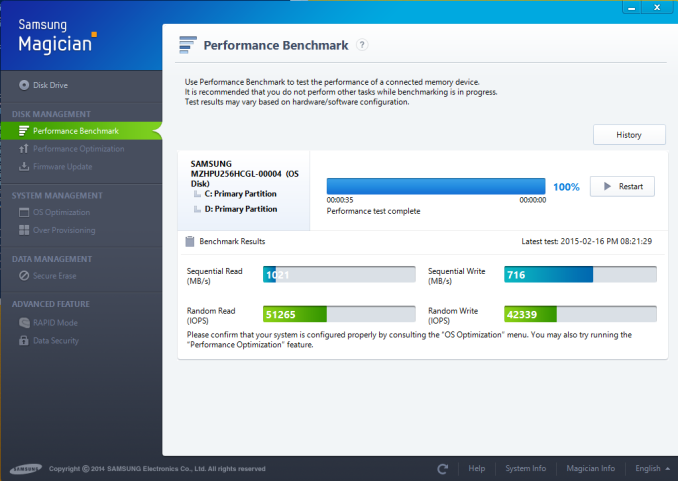Intel NUC5i5RYK Review: A Broadwell-U UCFF PC for Enthusiasts
by Ganesh T S on February 20, 2015 8:00 AM ESTNetworking and Storage Performance
We have recently started devoting a separate section to analyze the storage and networking credentials of the units under review. On the storage side, one option would be repetition of our strenuous SSD review tests on the drive(s) in the PC. Fortunately, to avoid that overkill, PCMark 8 has a storage bench where certain common workloads such as loading games and document processing are replayed on the target drive. Results are presented in two forms, one being a benchmark number and the other, a bandwidth figure. We ran the PCMark 8 storage bench on selected PCs and the results are presented below.


While the storage subsystem score doesn't bring out the efficacy of the M.2 PCIe SSD, the storage bandwidth number shows a chart-leading 322 MBps for the XP941 in the NUC5i5RYK. For good measure, we also ran the inbuilt benchmark in Samsung Magician (which doesn't support XP941 due to its OEM nature) to make sure that the SSD was utilizing the full capabilities offered by the PCIe lanes.
Sequential reads came in at 1 GBps and sequential writes at 716 MBps. Random accesses had upwards of 40K IOPS. All these point to the NUC5i5RYK possessing a ultra-compact platform with support for insanely fast primary storage media.
On the networking side, we restricted ourselves to the evaluation of the WLAN component. Our standard test router is the Netgear R7000 Nighthawk configured with both 2.4 GHz and 5 GHz networks. The router is placed approximately 20 ft. away, separated by a drywall (as in a typical US building). A wired client (Zotac ID89-Plus) is connected to the R7000 and serves as one endpoint for iPerf evaluation. The PC under test is made to connect to either the 5 GHz (preferred) or 2.4 GHz SSID and iPerf tests are conducted for both TCP and UDP transfers. It is ensured that the PC under test is the only wireless client for the Netgear R7000. We evaluate total throughput for up to 32 simultaneous TCP connections using iPerf and present the highest number in the graph below.

In the UDP case, we try to transfer data at the highest rate possible for which we get less than 1% packet loss.

Intel's AC7265 now behaves like a true 2x2 solution compared to the AC7260 in our testbed. While the numbers are not as good as those obtained with Broadcom-based 802.11ac WLAN cards, the improved performance is quite welcome.











83 Comments
View All Comments
Jaybus - Saturday, February 21, 2015 - link
I have one of the Haswell Celeron NUCs, DN2820FYKH, and it has plenty of power for HTPC use. Also, if you want to hide it away, it comes with a VESA mount adapter to bolt to the back of the monitor. Nice if your monitor mount has the space or if your monitor isn't wall mounted.GTVic - Saturday, February 21, 2015 - link
ChromeCast gets very hot. Not sure the technology is there for a computer on a stick.Shadowmaster625 - Friday, February 20, 2015 - link
Why are there no AMD APUs on these graphs? Some nvidia tablet chip data would seem relevant also. Thinks are looking rather dire for intel.BlueBlazer - Saturday, February 21, 2015 - link
Can find those benchmarks here http://www.anandtech.com/show/8119/amd-launches-mo... for comparison. And that's AMD's current top mobile SKU although it has a rather high 35W TDP.mfenn - Friday, February 20, 2015 - link
The word should be envelope not envelop on the last page.vsilgalis - Friday, February 20, 2015 - link
I'm really disappointed that none of the NUCs have dual ethernet ports on them. I really want to use NUCs as servers for personal use, but really don't like USB ethernet dongles.dakishimesan - Friday, February 20, 2015 - link
There are several do it yourself solutions that come very close to the functionality you want:http://www.supermicro.com/products/chassis/Mini-IT...
https://www.supermicro.com/Aplus/motherboard/embed...
http://www.supermicro.com/products/motherboard/ato...
bobbozzo - Friday, February 20, 2015 - link
I've heard that Intel makes a mini-PCIe gigE card; a hole can be cut the the back of some of the NUC cases for the RJ45 port.dakishimesan - Friday, February 20, 2015 - link
http://www.amazon.com/Syba-Gigabit-Ethernet-Contro...Realtec
Brian_R170 - Friday, February 20, 2015 - link
This review states twice that the first NUCs had Sandy Bridge CPUs. This is not correct. The very first NUCs were the DC33217IYE and DC33217BY. Both of these used the Core i3-3217U, which is an Ivy Bridge CPU. Intel never offered a Sandy Bridge-based NUC.